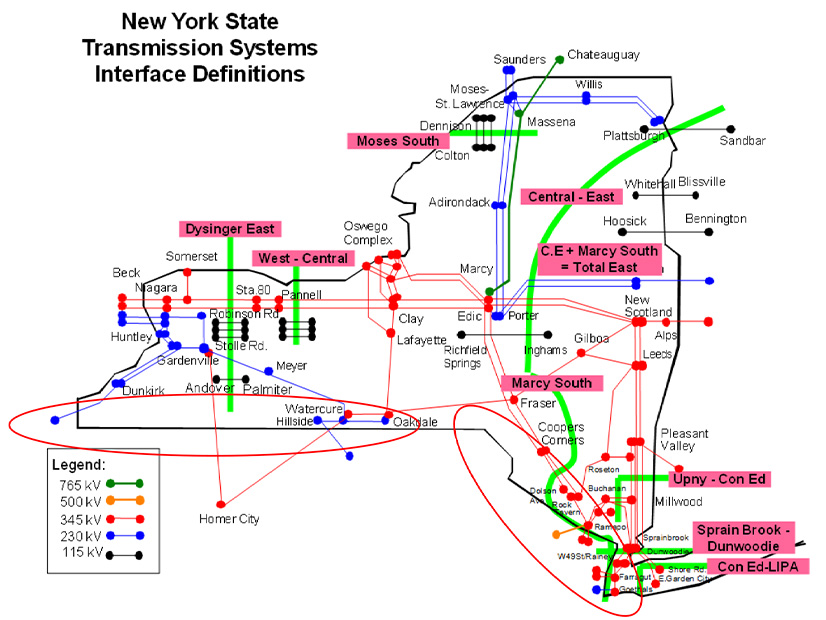ISO: Champlain Hudson Critical to NY Reliability in Future
The NYISO Operating Committee last week approved the ISO’s draft 2022 Reliability Needs Assessment (RNA), which did not identify any reliability needs for the 10-year study period but found that resource adequacy and transmission security margins are tightening over time.
But NYISO emphasized that the Champlain Hudson Power Express (CHPE) transmission project is critical to meeting future reliability needs, and delays could result in even thinner margins, creating significant risks to certain peakers who may be asked to continue operation when they otherwise would be unavailable because of non-compliance with new rules. An ISO representative said that “we’re putting all of our reliability eggs into the CHPE basket.”
The state also views the HVDC line, which would run from Quebec to New York City, as critical to its clean energy goals. (See NYSERDA Seeks 1-Year Delay for Tier 4 RECs.)
The report also noted that New York is likely to experience even smaller margins if additional power plants become unavailable or if future demand outpaces current forecasts. (See “RNA Draft Report Findings,” NYISO Transmission Planning Advisory Subcommittee Briefs: Oct. 3, 2022.)
The RNA also found that extreme weather events can result in transmission security deficiencies in the city, while gas supply shortages during winter peak conditions can eventually threaten reliability needs after 2032, when gas is predicted to become deficient in meeting statewide system needs.
The draft will be presented to the Management Committee on Wednesday for voting and to the NYISO Board of Directors for final approval in November.
NYISO-PJM Stability Analysis
NYISO recommended that its interconnection reliability operating limit (IROL) with PJM be removed after a study showed no stability issues even at transfer levels well in excess of the limit.
Robert Golan, NYISO manager of operations and engineering, presented the OC with the results of the study, which modeled three 115-kV tie lines with maximum transfers, winter ratings and optimized generation dispatch. NYISO-to-PJM flow achieved an emergency transfer limit of 2,440 MW, while PJM to NYISO achieved 3,175 MW.

The study also evaluated 61 NYISO and 68 PJM contingencies, finding that for NYISO to PJM, transfer levels were increased to 164% of the limit, giving the ISO a new proposed stability limit of 3,600 MW. From PJM to NYISO, the emergency transfer thermal limits increased to 150%, creating a new proposed limit of 4,250 MW.
The ISO “saw acceptable responses” in both the New York Control Area and PJM when examining “both angular and voltage response of each system,” Golan said.
Golan was quick to note, however, that both NYISO and PJM would reassess the need for the reinstatement of an IROL based on future system changes and five-year periodic reviews.
In response to questions around PJM’s status, Golan said NYISO has been “working hand-in-hand with PJM over the past year,” and that the RTO is currently waiting for the ISO to “go through the stakeholder process so that they can know when this report is approved.”
CESIL Updates
The committee approved manual updates implementing recently approved tariff revisions that preclude demand-side resources from curtailing critical electric system infrastructure load (CESIL) in response to ISO-called events and tests, beginning Nov. 1.
CESIL includes natural gas compressors and storage facilities; LNG storage, liquification and vaporization; refineries; electric system control centers; and natural gas system control centers, terminals, and metering and regulation stations. The revisions are intended to improve conditions for the upcoming winter, when gas supplies may short. (See “Critical Infrastructure Load,” NYISO Business Issues Committee Briefs: June 22, 2022.)
Ancillary Services
The committee also approved manual revisions regarding NYISO’s voltage support, operating reserves and black start capability services, such as preparing for the possibility of new technologies entering black start capability service and adding a 15-business-day window for ISO review of voltage support test data.
The ISO incorporated a “wish list of little things” that it had wanted to include in their manuals to confirm that market and review functions were in line with real-time situations.
Along with the new review period for voltage support reporting submissions, NYISO added a new allowance for out-of-period reactive capability testing and clarified language around data transmission requirements.
The 15-day review period was welcomed by stakeholders, with Brookfield Renewable’s Christopher LaRoe saying that the proposal for “the ISO to reply with a status besides ‘pending’ is helpful” because it will solve the current problem of “tight time constraints around the deadlines for suppliers to submit data for testing.”
The ISO also made terminology changes within its black start capability manual that would prevent innovative technologies from being excluded from these processes, with NYISO’s Harris Miller stating that the ISO is “trying not to exclude anyone.”
The changes become effective Nov. 1.
Interconnection Queue Streamlining
Zach Smith, NYISO’s vice president of system resource and planning, told the committee that the ISO has identified analyses that can be eliminated from the System Reliability Impact Study (SRIS) for 30 to 40 projects in the interconnection queue.
Smith noted that NYISO has been actively looking for ways to expedite SRIS processes to fix the backlog of projects currently waiting in the interconnection queue. (See NYISO Proposes Fixes for Interconnection Backlog.)
The categories identified are “immediate actions the ISO can take” to address these concerns without “sacrificing the quality of work or reliability of the grid” while remaining “in compliance with the relevant tariff and NERC standards,” according to Smith.
Stakeholders expressed support for these efforts, with Kaley Bangston from Invenergy stating that her team “thanks the ISO for putting the work and thoughts together to make this happen.”
NYISO plans to return to the Transmission Planning Advisory Subcommittee and the OC in November to share a more detailed list of projects that the ISO proposes to modify the study scope.


